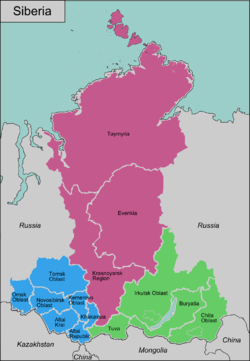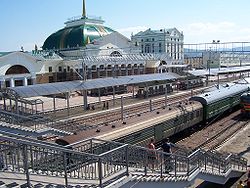Siberia
Siberia (Russian: Сиби́рь see-BEER') is a region in Russia. Historically, the term Siberia includes all Russian territory in north Asia, with the Urals and the Russian Far East; this article however only covers the Siberian Federal District.
Regions
[edit]
| Western Siberia (Altai Krai, Altai Republic, Khakassia, Kemerovo Oblast, Novosibirsk Oblast, Omsk Oblast, Tomsk Oblast) |
| Krasnoyarsk Krai (Evenkia, Krasnoyarsk, Taymyria) |
| Eastern Siberia (Buryatia, Zabaykalsky Krai, Irkutsk Oblast, Tuva) |
Cities
[edit]
Other destinations
[edit]- 1 Lake Baikal. The pearl of Siberia. It is the deepest and one of the purest lakes in the world.
- 2 Lake Teletskoye. Biggest and deepest lake on Altay mountains.
- Siberian Route One of the longest historical routes from Tsar Russia times spanning 8888 km from Moscow or Veliky Novgorod to Beijing.
- Chuysky Trakt One of the most picturesque old mountain roads of Russia. Historical part starting from Biysk ending in Mongolia.
- Sayany Ring Circle mountainous road from Abakan to Kyzyl, Ak-Dovurak, Abaza ening in Abakan.
Understand
[edit]- See also: Russian Empire, Soviet Union

The name is of Turkic origin, "su" (water) and "bir" (wild land). With an area of nearly 10 million sq km., Siberia is vast. While the popular view of Siberia is of howling Arctic wastes dotted with penal colonies, the truth is more complex. The west of Siberia is covered by a swampy plain, the central plateau is heavily forested, and the east has mountains soaring to above 3,000 m. Only the extreme north is true tundra, with permafrost and temperature means that don't get over 10 °C (50 °F) even in July, but all of Siberia has cold winters.
The indigenous Siberians, like most indigenous Asian Russians, are more closely related to Turkic peoples or to the Inuit than to ethnic Russians. However, during Imperial Russian and Soviet times the government gave Europeans many incentives to settle in Siberia. Today the population of Siberia is majority ethnic Russian, though rural areas remain largely populated by the indigenous Siberians.
Talk
[edit]As with anywhere else in Russia, Russian is the dominant language in Siberia. However, there are also many indigenous languages that are spoken by their respective ethnic groups, particularly in rural areas. Almost everybody speaks Russian regardless of what their native tongue is, but learning some phrases in the indigenous languages can help ingratiate you to the locals.
English is spoken by few even at a very basic level, and other foreign languages by fewer than in Western Russia. Knowing Russian is essential.
Get in
[edit]By train
[edit]
The Trans-Siberian Railway, connecting Moscow to Vladivostok, is by far the most famous method of transportation in Siberia. Covering a distance of 9,289 kilometres, making it one of the longest railways in the world, the full trip takes over 6 days and crosses 8 time zones. Its branches the Trans-Manchurian and Trans-Mongolian connect to Beijing in China, the first directly, the second via Ulaanbaatar in Mongolia.
Less famed is the Baikal-Amur Mainline (BAM), a northern line running parallel to the Trans-Siberian for 4,234 km. Completed only in 1991 and built mostly for military reasons, further away from the border of China, the BAM is less popular with tourists.
By car
[edit]The Trans-Siberian Highway, an unofficial grouping of seven Russian federal highways, open the path for a 11000km cross-country journey from St. Petersburg and Moscow to Vladivostok. The last section, the Amur Highway, was paved in 2010.
Get around
[edit]There are local air companies like S7, Krasavia, Nordavia and Iravia connecting all major destinations in the region also many remote places. Trains are great option to visit minor destinations. Scheduled buses can be found on almost every direction. Carpooling is also well represented. Taxy could be hauled via YandexGo app or some intercity directions serviced by private companies. Hitchhiking is possible and quite effective in every season in any direction, but please have at least proper clothes and tent. Every major regional city has private renting services where you can book and rent desirable vehicle.
See
[edit]
Primarily natural attractions.
- Mountainous Altai (Gorny Altai) — this region of Siberia is very popular among eco tourists. Mountaineering and mountain rivers' rafting are wide spread here. The area is famous for its stunning scenery. The mountains straddle the border between Altai Krai and the Altai Republic.
- Siberian Traps is a large region of volcanic rock, originating in supervolcano activity 250 million years ago, continuing for 1–2 million years and causing extinction of most species of life. With an area of 7 million km2 (3 million sq mi) it covers much of Siberia.
Do
[edit]
With its vast areas of wilderness, Siberia is a challenging destination for outdoor life.
- Mushroom picking
- Hot and mineral springs in Siberia are numerous and offer services from wild stone bath to luxury resorts
- Hiking
- Tour cycling
- Downhill snowsports
- Cross country skiing
- Kayaking and rafting, both in white water and in flat water, have official sports associations and informal clubs
- Dog sledding
- Ice skating on Baykal
- Nature observation – birdwatchers number are steadily growing
- Astrophotography and observations of the sky – Siberia due to its vastness and scarce population mostly has zero light pollution.
- Enduro touring by motorcycle in Siberia offers nearly endless possibilities with many rent stations and almost no restrictions on offroad activities
Eat
[edit]- See also: Russian cuisine
There are more than 35 indigenois nations originating in Siberia so in Siberia there is not only Russian cuisine. In total there is more than 120 nations living in Siberia. Every nation has its own national cuisine. Some you can taste in big cities, others you need to go far and visit local people. Megapolises like Novosibirsk and Krasnoyarsk has many restaurants with great variety of local cuisine.
Drink
[edit]- Vodka (водка) and tea (чай)


 Français
Français Italiano
Italiano



